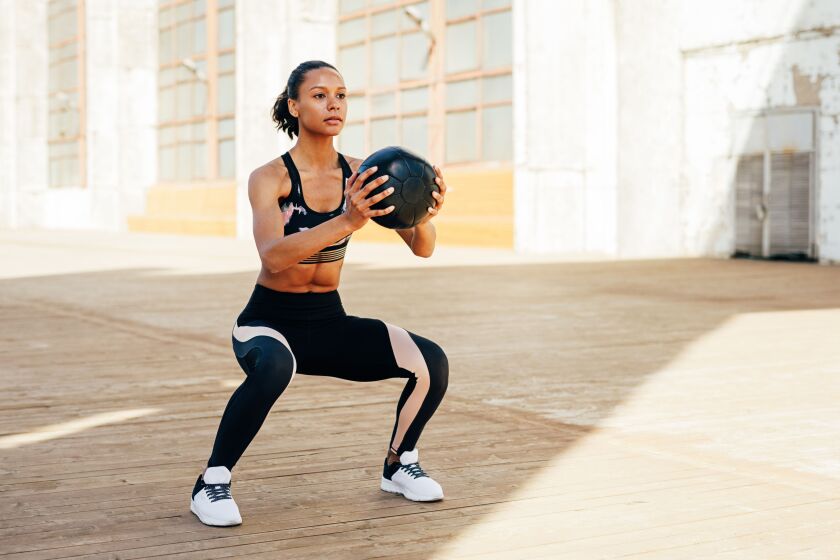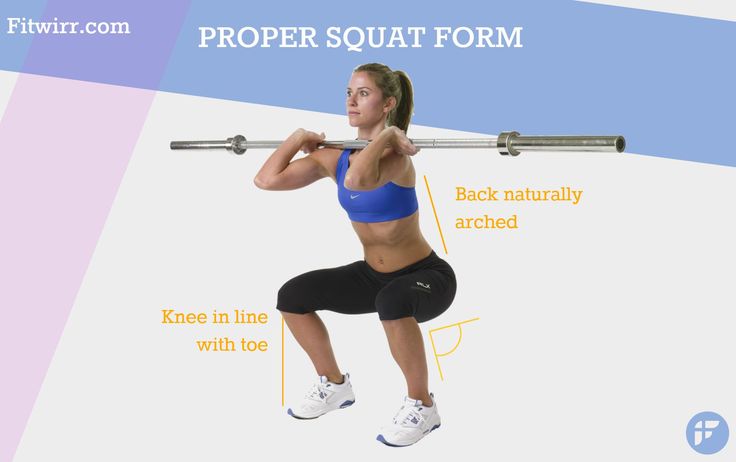Proper squat form is crucial for avoiding back injuries. This article will guide you through step-by-step instructions on how to squat correctly to protect your back.
:max_bytes(150000):strip_icc()/Squat-Therapy-GettyImages-1285245435-39983054bd9e41109c7e80f2a8d2a240.jpg)
Credit: www.shape.com
Importance Of Proper Squat Form
Learn the 7 keys to perfect squat form from exercise experts. Proper squat form is essential to avoid injury and maximize results. Follow these guidelines to ensure you are squatting correctly and safely.
Proper Squat Form: Importance of Proper Squat Form Incorporating squats into your workout routine offers numerous benefits for your overall strength and muscular development. However, it’s crucial to perform squats with proper form to maximize these benefits and prevent any potential injuries. Exercise experts agree that mastering proper squat form is essential for a safe and effective workout. Let’s explore the importance of proper squat form and how it can help you reach your fitness goals.Prevent Injury
One of the primary reasons why proper squat form is crucial is to prevent injury. When you perform squats incorrectly, you place unnecessary stress on your joints and muscles, increasing the risk of strains, sprains, and other injuries. By maintaining proper body alignment, distributing the weight effectively, and engaging the right muscles, you can minimize the risk of injury during squats.Maximize Strength And Muscular Development
Proper squat form allows you to target the correct muscles and engage them fully. When you execute squats with proper technique, you activate your quadriceps, hamstrings, glutes, and core, leading to maximum strength and muscular development. By focusing on maintaining an upright posture, keeping your knees aligned with your toes, and achieving the appropriate depth, you can optimize the benefits of squats and enhance your overall strength.Improve Functional Movement
In addition to preventing injuries and building strength, proper squat form also improves your functional movement. Squats are considered a compound exercise that mimics everyday activities such as sitting down and standing up. By practicing proper squat form, you can enhance your hip mobility, ankle stability, and overall balance, making it easier for you to perform daily tasks and maintain an active lifestyle. In conclusion, the importance of proper squat form cannot be overstated. By following the 7 keys to a perfect squat and prioritizing proper body alignment, weight distribution, and muscle activation, you can prevent injuries, maximize your strength and muscular development, and improve your functional movement. Incorporating proper squat form into your workout routine will not only enhance your performance but also help you achieve your fitness goals safely and effectively.
Credit: www.pinterest.com
7 Keys To A Perfect Squat
Exercise experts reveal the 7 keys to a perfect squat, emphasizing the importance of proper squat form. Focus on maintaining a neutral spine, shifting weight to your heels, and guiding your hands backward as you lower into a squat. By following these guidelines, you can effectively perform squats with safety and precision.
Maintain Proper Alignment
Achieving proper alignment is essential for a perfect squat. Start by standing with your feet shoulder-width apart, ensuring that your toes are pointing slightly outward. Keep your chest up and your back straight throughout the entire movement. Your knees should align with your toes to prevent strain and injury.
Engage Core And Upper Body
Engaging your core and upper body during a squat helps to maintain stability and prevent injury. Keep your chest and head high, pull your shoulders back and down, and keep your spine in a neutral position. This will help you maintain proper form and distribute the weight evenly.
Shift Weight To Heels
To perform a squat correctly, it’s important to shift your weight to your heels. When lowering into the squat position, focus on working your hips backward while maintaining a neutral spine. This engages the glutes and hamstrings, reducing strain on the knees.
Maintain Neutral Spine
Keeping a neutral spine throughout the squat is crucial for proper form and preventing back injuries. Avoid rounding or arching your lower back. Instead, engage your core and focus on keeping a straight line from your head to your tailbone.
Controlled Descent And Ascent
Controlling the descent and ascent of the squat is key to building strength and avoiding injury. Avoid dropping down too quickly or bouncing at the bottom. Lower yourself in a controlled manner, keeping tension in your muscles, and push through your heels on the way up.
Full Range Of Motion
Performing squats with a full range of motion maximizes the benefits of the exercise. Aim to lower your hips until your thighs are parallel to the ground, or as close as possible. This helps to engage all the major muscle groups in your lower body and improves flexibility.
Proper Breathing Technique
Using the correct breathing technique during a squat can enhance your performance. Take a deep breath in before you lower into the squat position, and exhale as you push back up. This helps to stabilize your core and provide oxygen to your muscles.
Common Mistakes To Avoid
While performing squats, there are 7 keys to keep in mind for proper form, according to exercise experts. These include holding your chest and head high, pulling your shoulders back and down, and maintaining a neutral spine. Additionally, shift your weight to your heels and focus on working the hips backward.
the box, straightening your legs, while keeping your knees slightly bent. Avoid using your arms to push off the box. Repeat 10-15 times. Now let’s dive deeper into the common mistakes to avoid when performing squats:Knees Caving Inward
One of the most common mistakes individuals make during squats is allowing their knees to cave inward. This not only puts excessive stress on the knee joints but also compromises the stability of the movement. To avoid this, make sure your knees are tracking in line with your toes throughout the entire squat motion. Focus on pushing your knees outwards to maintain proper alignment and stability.Lack Of Depth
Another mistake to avoid is not going deep enough in your squat. Failing to reach proper depth can limit the activation of important muscles like the glutes and hamstrings. Aim to go as low as you comfortably can while maintaining proper form. As a general guideline, aim to have your hips sinking lower than your knees. Remember to engage your core for stability and control throughout the movement.Rounding The Back
Rounding your back during squats is a common mistake that can lead to injuries, especially in the lower back. Keeping a neutral spine throughout the movement is crucial for maintaining proper form and distributing the load evenly across your body. Focus on keeping your chest up, shoulders back, and core engaged to maintain a neutral spine position. If you struggle with this, try reducing the weight or seeking guidance from a qualified fitness professional.Lifting Heels
Lifting your heels off the ground during squats can throw off your balance and shift the load to the front of your feet, putting unnecessary strain on your knees. To prevent this, make sure your weight is evenly distributed through your entire foot, with your heels firmly planted on the ground. If you struggle with maintaining balance, you can try placing small weights, like plates or books, under your heels to provide some support until you improve your ankle mobility. By avoiding these common mistakes, you can ensure that you are performing squats with proper form, maximizing the effectiveness of the exercise and minimizing the risk of injury. Remember to start with lighter weights and gradually increase as you build strength and confidence in your squat technique.
Credit: chicago.suntimes.com
Frequently Asked Questions On Proper Squat Form: 7 Keys To A Perfect Squat, Say Exercise Experts
How Do You Do A Proper Squat Form?
To perform a proper squat form, follow these guidelines: 1. Stand with feet shoulder-width apart. 2. Keep chest up and back muscles straight. 3. Lower down by bending your knees until your buttocks gently touch the box. 4. Maintain a neutral lower back position.
5. Rise back up without actually sitting.
What Are The Keys To Performing Squats Correctly And Safely?
To perform squats correctly and safely, follow these guidelines: 1. Stand with feet shoulder-width apart. 2. Keep chest and head high, with shoulders pulled back and down. 3. Maintain a neutral spine and shift weight to heels. 4. Place hands on hips and guide them backward as you bend knees to lower into a squat.
5. Focus on working hips backward while keeping spine neutral. By following these steps, you can ensure proper form and minimize the risk of injury during squats.
What Is The Ultimate Guide To Squats?
The ultimate guide to squats is a step-by-step tutorial on how to do squats correctly. Start by standing with your feet shoulder-width apart and keeping your chest up. Lower yourself by bending your knees and keeping your back straight. Focus on maintaining proper form to avoid injuring your back.
How To Do Perfect Body Squat?
To perform a perfect body squat, follow these guidelines: 1. Stand with feet shoulder-width apart. 2. Keep chest up, back straight, and gaze forward. 3. Lower your body by bending your knees and pushing your hips back. 4. Keep your weight on your heels and maintain a neutral spine.
5. Rise back up by straightening your legs. By following these steps, you can ensure proper form and avoid injury during your squats.
Conclusion
To perform a perfect squat and avoid unnecessary back pain, it is crucial to prioritize proper form. By following the seven keys outlined in this blog post, such as maintaining a neutral spine and shifting your weight to your heels, you can ensure that you are executing squats correctly.
Incorporating these techniques into your workout routine will not only enhance your strength and stability but also reduce the risk of injury. So, let’s squat properly and reap the benefits of a safe and effective exercise.

